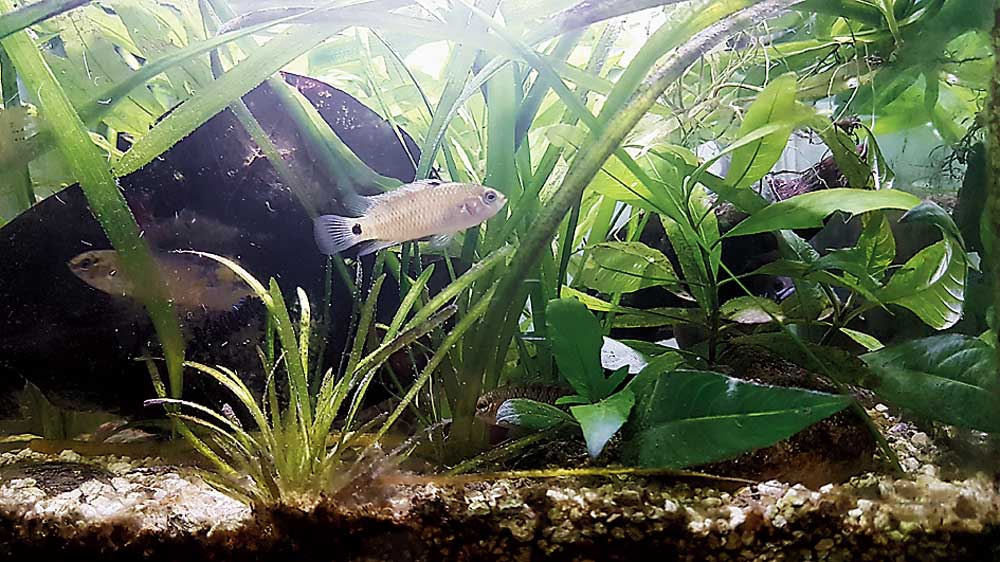Laymen would call them aquariums but they’re so much more than that. The tank in Deepta Chakravartty’s dining room has a riverbed replicating the one in the Brahmaputra, pebbles and plants that are found in the Brahmaputra, driftwood and sand just like in the Brahmaputra. And all this to create a native environment for his fish, that are wild-caught from the river Brahmaputra.
“This is a biotope, where we replicate an animal’s native environment in an enclosed space,” says Chakravartty, a BL Block resident who is a fisheries scientist and entrepreneur. “While we do such things on a large scale in hatcheries I wanted to try it out at home.”
Chakravartty has chosen two sites to base his biotopes on — the larger one replicates the lower Assam region of the Brahmaputra. The second and smaller tank, in his living room, mimics north Bengal rivers such as in the Dooars.
Unlike in an aquarium, Chakravartty can’t up pick up whatever he fancies from the pet shop. Every component of his tanks is carefully selected and allowed in a measured quantity. So there’s sand from the riverbank, plants, rocks and vegetation that are found in the real rivers...
“The smaller tank has a base of the mineral zeolite, that absorbs toxins. I place a leaf of sun-dried guava or Indian almond (badam gachh) as they release tannins, which nourish the fish,” says Chakravartty. Next come aquatic plants that release oxygen and absorb ammonia that the fish release, thereby maintaining a balance in the water. Snails too have been released to eat algae and detritus build-up in the tank.

Some Badis Badis fish swim about in the tank that replicates the vegetation and habitat of north Bengal rivers Telegraph picture
Finally, come the fish. The smaller tank has a five-inch long Channa Andrao that has a base colour of reddish brown. There are several smaller Badis Badis, of which all are male. “One is the alpha male, the others pseudo male. This means they are male but change their colour and pretend to be female so they are not attacked by the alpha,” he explains.
The fish are territorial but need small spaces to themselves. The largest fish — the Channa Andrao — has occupied the corner from where Chakravartty drops food. “This fish could actually be eating the Badis Badis in the wild but does not do so here as I provide him with tastier live food (caterpillars and earthworms).”
Again, unlike in regular aquariums, these fish are usually fed once in three or four days. “That is how they feed in the wild. Plus, they get less exercise here and do not require more food.”
Chakravartty says the toughest part is to mimic the temperature of the river round the year. “Since people feel cold and try to keep warm in winter, they tend to do the same for their pets. But a biotope keeps the temperature as close to that in the wild,” he says.
As the tanks are indoors, he uses artificial lights to enable photosynthesis in the plants and uses ACs and blowers to manipulate the temperature of the water. Its success can be gauged by the fact that in winter, his Rainbow Snakehead fish behaved just as it would in the Brahmaputra. “This fish went into aestivation, or semi-hibernation. He slept the whole day in a burrow but come out once a day to eat.”
The larger tank also has Cinnamon Loach that dig through the sand and Honey Gourami, the female of which has laid eggs recently. “The eggs look like a network of glass beads but they may not survive as the other fish could eat them. In any case, breeding is not my objective.”
In the wild during monsoon, rivers receive a lot of fresh water and so Chakravartty changes about 30 to 40 per cent of the water in his tanks every week. In the dry season, this reduces to 20 per cent water change a month. So now, at the end of winter, his tank wears a desiccated look. The water level is low, much of the plants are exposed and the fish are at home.











